Please use this identifier to cite or link to this item:
https://hdl.handle.net/20.500.12544/3798Files in This Item:
| File | Description | Size | Format | |
|---|---|---|---|---|
| Martinez-Late-Paleozoic_Chocolate_Formation.pdf | Artículo de congreso | 117.66 kB | Adobe PDF | View/Open |
This item is licensed under a Creative Commons License












